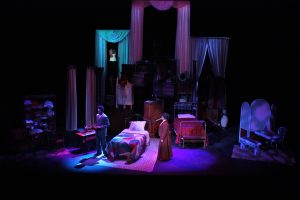As the pandemic continues, theaters struggle to stay on board this ever rocking ship. Every week it seems communities change and adjust to the “new normal”. But what are the effects of COVID-19 on theaters? How can an industry and a community entirely driven by large groups of people change to customize themselves to fit into the new social distance mold?
Jared Morin, Artistic Director for Planet Ant’s Black Box Theatre Season, says, “We, along with many other theaters in the area, are sort of at a standstill.” He continues by saying that COVID-19 has, and will continue, to deeply affect theaters until there is a definitive resolution to the virus. For Morin, the idea of innovating and adapting the classic structure of venues in a way where the audience is indoors is still not safe at this time. Specifically, those structures relate to bringing patrons and audiences into enclosed spaces. “The facts that we know about coronavirus still leave us with a lot of questions unanswered about its transmission, incubation, etc. And I don’t think anyone is willing to take risks on something so uncertain, especially with our staff and supporters who we cherish.”
Since the idea of indoor theater is out of the question for most in the theatre scene, how can this beloved form of art stay alive? It may simply be a way of switching the mindset. Taking a traditional act, something so ingrained in our world and society, and turning it on its head. It is as though each familiar system of our world has become its own Rubik’s Cube puzzle. We just have to take ideas, patterns, and processes and switch them around until something works. As Director of Marketing and Audience Engagement at Wayne State University, Thomas Karr says “Our function is the same, but our tools will be different.”

DERELL JONES (L) AND INDIGO COLBERT (R) INTIMATE APPAREL, BY LYNN NOTTAGE PERFORMED AT WSU BONSTELLE THEATRE. PHOTO WAYNE STATE
For the Bonstelle and Hilberry theaters, these different tools include live streaming, recording and sharing skits and dances, putting together live, in-person outside events in parking lots and on campus, as well as drive-by events. Dance and theater students of Wayne State University have created and led virtual events on Facebook and Youtube. These events have received a far greater number of viewers than events produced within their theaters before the pandemic. This new way of production brings new hope and excitement to the community that is already so intent on sharing stories and art.
Soon to be the chairperson of the Department of Theater and Dance at Wayne State University, Dr. Mary Anderson says, “They have been so resilient. But at the same time, I grieve their losses. This time has been incredibly disruptive and alienating for them.” To this, Morin says, “It does not feel great, not being able to do what you love.”
Anderson comments on recent events in correspondence with theater itself, “The acceleration of circumstances within the last few weeks have caused a very cataclysmic moment that almost dwarfs the questions because it turns everything upside down.” Considering the protests in Detroit for Black Lives Matter, Anderson sees a whole new and deeper set of questions that beg to be asked. “What are our commitments to social justice?” she asks rhetorically, “What are our commitments to creating spaces for inclusion connecting to uplifting voices who have been marginalized?” For different theaters and communities, obviously these questions will be answered differently, but even beyond the institutions themselves, these questions can be asked by the individuals that operate within them.
Anderson continues, shifting slightly to discuss the paradox she perceives that the pandemic and protests have created, “We are living in a time of precarity and a time of scarcity, but there is extraordinary generosity amongst institutions and individuals of all scales that is leading to a culture of abundance.” It truly is amazing to watch the theater scene, a community based within a group of people so intent on inclusion, art, and sharing of life and stories, almost seem to flourish as their community grows larger and stronger. Using their talents and abilities to help those around them and attend to important matters at hand instead of falling prey to the focus of loss. And, as time goes on, they lift up and support other suffering communities and share their newly crafted tools to change theater, and those affected by it forever.























